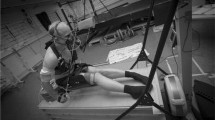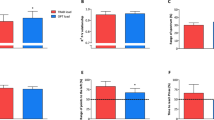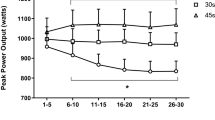Abstract
This study examined the effects of two resistive loads on fatigue during repeated sprints in children. Twelve 11.8 (0.2) year old boys performed a force–velocity test to determine the load (Fopt) corresponding to the optimal pedal rate. On two separate occasions, ten 6-s sprints interspersed with 24-s recovery intervals were performed on a friction-loaded cycle ergometer, against a load equal to Fopt or 50%Fopt. Although mean power output (MPO) was higher in the Fopt [397 (24) and 356 (19) W, P < 0.01], the decline in MPO over the 10 sprints was similar in Fopt [8.8 (1.9) %] and 50%Fopt [9.0 (2.4) %]. In contrast, peak power (PPO) was not different in sprint 1 between the two conditions [459 (24) and 460 (28) W], but was decreased only in 50%Fopt [11.4 (3.2) %, P < 0.01], while it was maintained in the Fopt despite the higher total work during each sprint. Fatigue within each sprint (percent drop from peak to end power output) was also higher in the 50%Fopt compared with the Fopt [32 (2.5) vs. 10 (1.6) %, P < 0.01]. Peak and mean pedal rate in Fopt condition were close to the optimum (Vopt), while a large part of the sprint time in 50%Fopt was spent far from Vopt. The present study shows that sprinting against Fopt reduces fatigue within and between repeated short sprints in children. It is suggested that fatigue during repeated sprints is modified when pedal rate is not close to Vopt, according to the parabolic power versus pedal rate relationship.





Similar content being viewed by others
References
Arsac LM, Belli A, Lacour JR (1996) Muscle function during brief maximal exercise: accurate measurements on a friction-loaded cycle ergometer. Eur J Appl Physiol 74:100–106
Bergstrom M, Hultman E (1988) Energy cost and fatigue during intermittent electrical stimulation of human skeletal muscle. J Appl Physiol 65:1500–1505
Bogdanis GC, Graham C, Louis G, Lakomy HKA, Nevill AM (1994). Effects of resistive load on power output during repeated maximal sprint cycling. J Sports Sci 12:128–129
Bogdanis G, Nevill M E, Boobis LH, Lakomy HKA, Nevill AM (1995) Recovery of power output and muscle metabolites following 30 s of maximal sprint cycling in man. J Physiol 482:467–480
Bogdanis GC, Nevill ME, Boobis LH, Lakomy HKA (1996) Contribution of phosphocreatine and aerobic metabolism to energy supply during repeated sprint exercise. J Appl Physiol 80:876–884
Bottinelli R, Canepari M, Pellegrino MA, Reggiani C (1996) Force–velocity properties of human skeletal muscle fibres: myosin heavy chain isoform and temperature dependence. J Physiol 495:573–586
Bottinelli R, Pellegrino MA, Canepari M, Rossi R, Reggiani C (1999) Specific contributions of various muscle fibre types to human muscle performance: an in vitro study. J Electromyogr Kinesiol 9:87–95
Caiozzo VJ, Baldwin KM (1997) Determinants of work produced by skeletal muscle: potential limitations of activation and relaxation. Am J Physiol 273:C1049–C1056
Capmal S, Vandewalle H (1997) Torque–velocity relationship during cycle ergometer sprints with and without toe clips. Eur J Appl Physiol 76:375–379
Carlson J, Naughton G (1994) Performance characteristics of children using various braking resistances on the wingate anaerobic test. J Sports Med Phys Fitness 34:362–369
Cherry PW, Lakomy HKA, Nevill ME, Maddox NL (1997) Effect of the number of preceding muscle actions on subsequent peak power output. J Sports Sci 15:201–206
Cherry PW, Lakomy HK, Boobis LH, Nevill ME (1998) Rapid recovery of power output in females. Acta Physiol Scand 164:79–87
De Haan A, Jones DA, Sargeant AJ (1989) Changes in velocity of shortening, power output and relaxation rate during fatigue of rat medial gastrocnemius muscle. Eur J Appl Physiol 413:422–428
De Ruiter CJ, Jones DA, Sargeant AJ, De Haan A (1999) The measurement of force/velocity relationships of fresh and fatigued human adductor pollicis muscle. Eur J Appl Physiol Occup Physiol 80:386–93
Dill DB, Costill DL (1974) Calculation of percentage changes in volumes of blood, plasma, and red cells in dehydration. J Appl Physiol 37:247–248
Dore E, Bedu M., Franca NM, Diallo O, Van Praagh E (2000a) Testing peak cycling performance: effects of braking force during growth. Med Sci Sports Exerc 32:493–498
Dore E, Diallo O, Franca NM, Bedu M, Van Praagh E (2000b) Dimensional changes cannot account for all differences in short-term cycling power during growth. Int J Sports Med 21:360–365
Dore E, Duche P, Rouffet D, Ratel S, Bedu M, Van Praagh E (2003) Measurement error in short-term power testing in young people. J Sports Sci 21:135–142
Dorel S, Bourdin M, Van Praagh E, Lacour JR, Hautier CA (2003) Influence of two pedaling rate conditions on mechanical output and physiological responses during all-out intermittent exercise. Eur J Appl Physiol 89:157–165
Dotan R, Bar-Or O (1983) Load optimization for the Wingate Anaerobic Test. Eur J Appl Physiol Occup Physiol 51:409–17
Durnin RVGA, Rahaman MM (1967) The assessment of the amount of fat in the human body from measurements of skinfold thickness. Br J Nutrition 21:681–689
Francescato MP, Girardis M, di Prampero PE (1995) Oxygen cost of internal work during cycling. Eur J Appl Physiol Occup Physiol 72:51–57
Gaitanos GC, Williams C, Boobis LH, Brooks S (1993) Human muscle metabolism during intermittent maximal exercise. J Appl Physiol 75:712–719
Hansen EA, Jorgensen LV, Sjogaard G (2004) A physiological counterpoint to mechanistic estimates of “internal power” during cycling at different pedal rates. Eur J Appl Physiol 91:435–442
Hautier CA, Linossier MT, Belli A, Lacour JR, Arsac LM (1996) Optimal velocity for maximal power production in non-isokinetic cycling is related to muscle fibre type composition. Eur J Appl Physiol 74:114–118
Hautier CA, Belli A, Lacour J-R (1998) A method for assessing muscle fatigue during sprint exercise in humans using a friction-loaded cycle ergometer. Eur J Appl Physiol 12:231–235
Hautier CA, Arsac LM, Deghdegh K, Souquet J, Belli A, Lacour J-R (2000) Influence of fatigue on EMG/force ratio and cocontraction in cycling. Med Sci Sports Exerc 32:839–843
Hebestreit H, Mimura KI, Bar-Or O (1993) Recovery of muscle power after high intensity short term exercise: comparing boys and men. J Appl Physiol 74:2875–2880
Jones NL, McCartney N, Graham T, Spriet LL, Kowalchuk JM, Heigenhauser JF, Sutton JR (1985) Muscle performance and metabolism in maximal isokinetic cycling at slow and fast speeds. J Appl Physiol 59:132–136
Jones PR, Pearson J (1969) Anthropometric determination of leg fat and muscle plus bone volumes in young male and female adults. J Physiol 204:63P–66P
Lakomy HKA (1986) Measurement of work and power output using friction-loaded cycle ergometers. Ergonomics 29:509–517
Linossier MT, Dormois D, Fouquet R, Geyssant A, Denis C (1996) Use of the force–velocity test to determine the optimal braking force for a sprint exercise on a friction-loaded cycle ergometer. Eur J Appl Physiol 74:420–427
Lodder MAN, Haan DA, Sargeant AJ (1991) Effect of shortening velocity on work output and energy cost during repeated contractions of the rat EDL muscle. Eur J Appl Physiol 62:430–435
MacIntosh BR, Svedahl K, Kim M (2004) Fatigue and optimal conditions for short-term work capacity. Eur J Appl Physiol 92:369–375
Martin JC, Spirduso WW (2001) Determinants of maximal cycling power: crank length, pedalling rate and pedal speed. Eur J Appl Physiol 84:413–418
Martin R, Hautier C, Bedu M (2002) Effect of age and pedalling rate on cycling efficiency and internal power in humans. Eur J Appl Physiol 86:245–250
Psek JA, Cafarelli E (1993) Behavior of coactive muscles during fatigue. J Appl Physiol 72:170–175
Ratel S, Bedu M, Hennegrave A, Dore E, Duche P (2002) Effects of age and recovery duration on peak power output during repeated cycling sprints. Int J Sports Medicine 23:397–402
Ratel S, Williams CA, Oliver J, Armstrong N (2004) Effects of age and mode of exercise on power output profiles during repeated sprints. Eur J Appl Physiol 92:204–210
Ratel S, Duche P, Williams CA (2006) Muscle fatigue during high-intensity exercise in children. Sports Med 36:1031–1065
Sargeant AJ (1994) Human power output and muscle fatigue. Int J Sports Med 15:116–121
Sjogaard G (1990). Exercise-induced muscle fatigue: the significance of potassium. Acta Physiol Scand Suppl 593:1–63
Tanner J.M (1962) Growth at adolescence. Blackwell Scientific Publications, Oxford
Taylor JL, Todd G, Gandevia SC (2006) Evidence for a supraspinal contribution to human muscle fatigue. Clin Exp Pharmacol Physiol 33:400–405
Williams CA, Carter H, Jones AM, Doust JH (2001) Oxygen uptake kinetics during treadmill running in boys and men. J Appl Physiol 90:1700–1706
Zanconato S, Buchthal S, Barstow TJ, Cooper DM (1993) 31P-magnetic resonance spectroscopy of leg muscle metabolism during exercise in children and adults. J Appl Physiol 74:2214–2218
Author information
Authors and Affiliations
Corresponding author
Rights and permissions
About this article
Cite this article
Bogdanis, G.C., Papaspyrou, A., Theos, A. et al. Influence of resistive load on power output and fatigue during intermittent sprint cycling exercise in children. Eur J Appl Physiol 101, 313–320 (2007). https://doi.org/10.1007/s00421-007-0507-7
Accepted:
Published:
Issue Date:
DOI: https://doi.org/10.1007/s00421-007-0507-7




